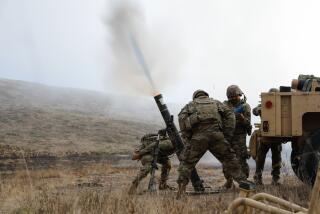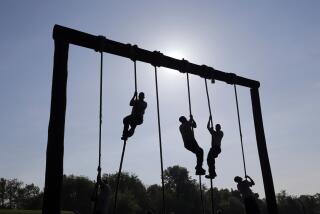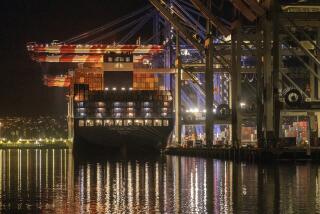From Kitchen Diplomacy to Giveaways, 16 Gulf Coast Cities Vie for New Navy Base
- Share via
LAKE CHARLES, La. — When the wind is right--and it often is--the pungent fumes spewing from the oil refineries and petrochemical plants here drift across the lake and settle over the city.
The view from Lakeshore Drive, Lake Charles’ most fashionable address, is of pipes and storage tanks and belching smokestacks on the opposite shore.
This city is not the most handsome of suitors, but, warts and all, Lake Charles is engrossed in a serious courtship. And the object of its affection is the United States Navy.
Rivals Abound
Lake Charles has its rivals. The Navy has taken pains to catch the eye of 15 other cities along the Gulf of Mexico, from Key West, Fla., to Brownsville, Tex. It has inspired a Gulf war in which the victor brings home $100 million in construction contracts, a $60-million annual payroll, an estimated 3,000 civilian jobs and 1,600 new families.
The winner gets a Navy base for six ships, including the vintage battlewagon Wisconsin, which will be pulled out of mothballs and refitted as part of an ambitious and expensive plan to expand the size of the American fleet from 527 to 600 vessels.
For many hard-pressed cities along the Gulf, union with the Navy would mean a desperately needed boost--particularly for places like Lake Charles, where oil and petrochemicals have been the city’s lifeblood.
As those industries have sagged, so have the cities that depended on them. Unemployment is reaching critical levels in ports all along the Gulf. In Pascagoula, Miss., one of the contenders for the battleship group, unemployment stands at 18.6%, close to triple the national unemployment average.
Offer Free Land, Millions
So Lake Charles and the others are going all out in the campaign to woo the Navy, offering everything from free land to millions of dollars in up-front money.
The Navy will also build new bases on the East and West coasts, but the decisions there were easier when compared to the hungry clamoring along the Gulf.
“Just the geographical spread of this makes it a much greater effort,” said retired Navy Capt. James J. Ridge, whose job has been to spend the last six months evaluating the 16 possible sites. Because a favorable nod from Ridge is so important, he and the others on the Navy team have been feted up and down the coast with everything from brass bands to country club receptions.
They first visited Lake Charles last Halloween, but the city is still awash in banners and signs that say “Sailors Make Good Neighbors.”
Lake Charles schoolchildren sent the Navy crayon drawings depicting how the sailors would be welcomed. The city spent $150,000 to prepare its proposal for the port, which is 30 miles inland. It has offered to match the $15 million the state would put up if a Louisiana site is chosen. The only other Louisiana contender is New Orleans.
Table-Top Diplomacy
The final bit of brinkmanship came when 81 of Lake Charles’ civic leaders chartered a plane and flew to Washington for a meeting with Navy officials. To lend a bit of Louisiana flavor to the gathering, they brought along crawfish etouffee, a Cajun delicacy, for lunch. Then they reboarded their plane and flew back to Lake Charles.
The final cost of this “dog and pony show,” to use a local description of it, was more than $30,000, but the leaders of Lake Charles thought it was an investment worth making.
“I am very optimistic and very sure this will be the new home port for the Navy,” said Mayor Paul Savoie. “We have offered them everything they could possibly want. We need this probably more than any other port on the Gulf. Basically, we are waiting for the announcement.”
If one listened only to Savoie, the clear impression would be that Lake Charles has the Navy in the bag. But all the competing cities, including many with more charm than Lake Charles, have gone to great lengths in the preparation of their proposals and with fanfare to press their cases.
Houston and Galveston, which are working on a joint proposal, dipped into their corporate talent pools and recruited more than 100 professionals who put together a detailed study that cost half a million dollars. Mississippi has offered to spend $17 million toward the construction of a causeway that might enhance the chances of flagging Pascagoula.
Pro-Navy Billboards
In Brownsville, Tex., Ridge and other members of his team were greeted to pro-Navy billboards and treated to lunch at the Marine Military Academy, a private preparatory school that grooms its students for Annapolis.
Its neighbor to the north, Corpus Christi, was giving the Navy a tour when the entourage came upon about 300 cheering citizens and a high school band playing “Anchors Aweigh.” Chamber of Commerce President Jimmy Lyles insists that the demonstration was spontaneous.
Lyles also said the chamber had printed 5,000 posters for Navy boosters to display, only to find, on the day before the team arrived, that none seemed to be showing up in windows around town.
“It really was a nice looking poster,” said Lyles. “They weren’t putting them in their windows because they had decided to have them framed. Everybody had them at the frame shop.”
Only a last-ditch, door-to-door effort by veterans organizations got the remaining posters prominently displayed, he said. The Corpus Christi chamber also distributed 20,000 bumper stickers that proclaimed “South Texas is Navy Country.”
All of this fanfare is not lost on the Navy, which has nevertheless gone to some lengths to impress upon the 16 suitors that it is looking for something more, although Ridge admits that the hoopla does not hurt.
Cost Reductions Important
“We have been universally welcomed,” said Ridge, a bespectacled, congenial man whose candor stops only at saying who the front-runners in the contest are. “I don’t think the Navy would want to go where it is not welcome. What I would put as more important is what they are willing to do to reduce the cost to the Navy. How wide are they going to open their pocketbooks. Are moths going to fly out or something else?”
The story of the Navy’s efforts to expand the fleet begins in the late 1970s, when events like the hostage crisis in Iran and the Soviet invasion of Afghanistan led government officials to the conclusion that the United States should be better prepared for Third World conflicts and that battleships could play a key role--as they later did with only limited success off the coast of Lebanon.
In 1981, President Reagan announced the plan to increase the fleet strength to 600 ships. With that plan came another, in which the Navy would build additional bases on the Pacific and Atlantic coasts, as well as the Gulf of Mexico.
The logic was that on each of the three coasts the fleet should be dispersed to avoid a repeat of the Pearl Harbor attack in World War II, in which the Japanese caught the Pacific fleet in a single port and severely crippled it.
Everett, Wash., will be the site for one of the two new West Coast bases. Ridge said the three candidates for the other home port are Long Beach, San Francisco and, ironically, Pearl Harbor.
Funding Withdrawn
Staten Island in New York Harbor was awarded the East Coast port, but Defense Secretary Caspar W. Weinberger has now withdrawn the $56 million in his proposed budget that would have been used to build that base, after he became irritated by demonstrations in New York protesting the possibility that the ships would carry nuclear missiles.
On the Gulf, though, there has been only a smattering of protest, most of it from a Houston-based group called the Safe Harbor Alliance for a Nuclear Free Gulf Coast. Houston Mayor Kathy Whitmire has said that the nuclear issue will be discussed when and if the city’s site, or the one in Galveston, is selected.
“I don’t think that will be a factor anywhere in the area,” said Joseph J. Krebs, who is spearheading the home port drive for New Orleans.
Ridge said the next step in the contest will be to review the mountains of proposals that he refers to as “ranging salvos,” the ones that will determine the extent each city is willing to go in its effort to lure the Navy. Then he said he will be going back for more, asking the cities for detailed dollar figures to help “translate those gentle words of support.”
Meanwhile, the cities are keeping their eyes on each other while espousing their own virtues. New Orleans points to its advantage as a cosmopolitan city, while Port Lavaca, Tex., says one of its strengths is its rural setting. One city official, who asked to remain nameless, said the competing ports would remain “blood enemies” until the competition was over.
Pensacola Port Criticized
Mobile, Ala., has criticized the port at Pensacola, Fla., as having a dangerous curve at its harbor entrance. Pensacola’s response is that it has not stopped the Navy from coming there for the last 160 years.
Corpus Christi officials were angered when their Democratic congressman, Solomon Ortiz, told the people of Brownsville he hoped they would get the port. Ortiz was in the unenviable position of having both cities in his district.
The Gulf war will end sometime this spring or early summer, when Navy Secretary John F. Lehman Jr. announces the winning entry. Politicians across the area are already at work, wielding whatever clout they have to influence the final choice, no matter what Ridge and his team recommend. But Ridge, sitting in the lobby of the Port Lavaca Holiday Inn, said that is not his problem.
“We are apolitical and will remain that way,” he said. “We’re trying to call them as we see them.”
Port Lavaca leaders were waiting nearby to escort the Navy team to a country club reception. And outside, the motel marquee said, “Welcome Navy.”
More to Read
Sign up for Essential California
The most important California stories and recommendations in your inbox every morning.
You may occasionally receive promotional content from the Los Angeles Times.










